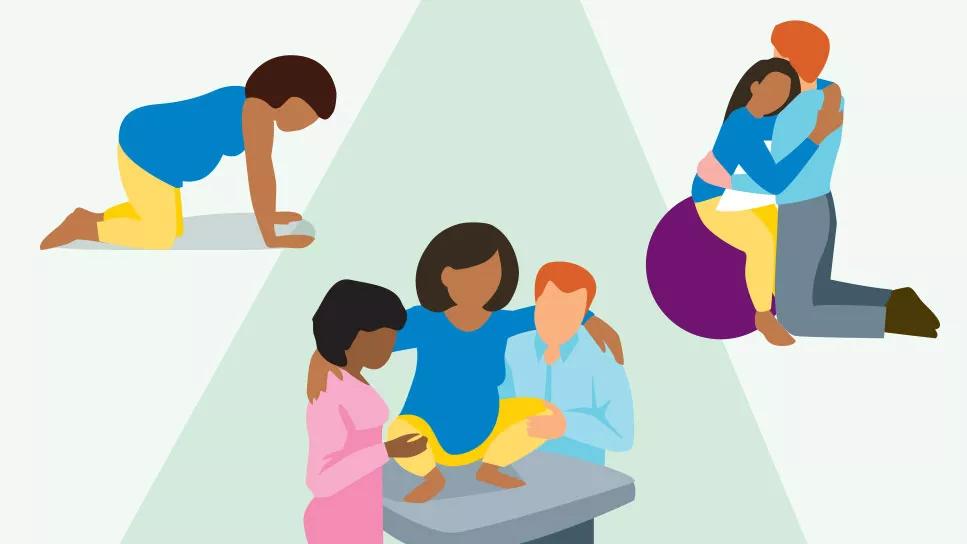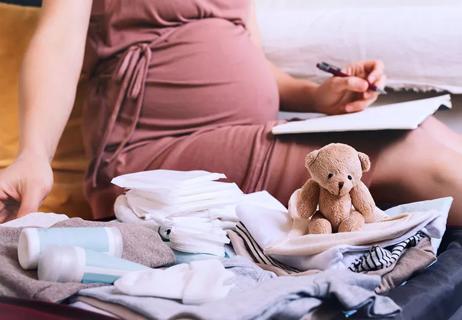Sitting, squatting and side-lying may provide a more comfortable labor and delivery

The average labor and delivery can last anywhere from eight hours to three days or more. It can be tough, and you may be concerned about how you’ll get through it. But you have the power to make yourself as comfortable as possible — by trying out a few different positions that may make those hours more manageable.
Advertisement
Cleveland Clinic is a non-profit academic medical center. Advertising on our site helps support our mission. We do not endorse non-Cleveland Clinic products or services. Policy
“You may think your only option is to lie on your back to give birth,” says certified nurse midwife Michelle Stiltner, CNM. “But there are other positions that can help move labor along and ease the birthing process.”
To better understand your options, Stiltner explains the labor and delivery positions she recommends most often.
Labor is the process of moving a fetus down through your pelvis. It starts when you first begin feeling contractions until you begin pushing.
Contractions help move the fetus out of your uterus through your cervix to your vaginal opening. Contractions can be painful. But how you position your body can help with the pain and make it easier for the fetus to make their way down.
It’s common and helpful to change positions throughout different stages of labor, depending on what makes you feel good. And what works can differ as you progress through labor.
Other factors may also make a difference in what labor positions work best for you, including:
Advertisement
“We encourage anyone with low-risk pregnancies to labor at home as long as possible,” Stiltner says. “So, you can try out many of these positions at home. Just pay attention to what feels good for your body.”
Stiltner adds that it’s not recommended to lie flat on your back. That’s because it doesn’t help to get the fetus moving, and it can reduce blood flow to your uterus.
Positions to consider during labor include:
Walking is beneficial throughout labor. For the most benefit, Stiltner recommends walking up and down stairs.
“Walking stairs — and especially walking stairs sideways — makes your hips and pelvis asymmetrical and helps the fetus drop down,” Stiltner says.
If you don’t have access to stairs or are looking for other walking options, consider:
Birthing balls are large air-filled exercise balls. They’re an excellent resource for every stage of labor.
But the birth ball isn’t for bouncing.
“There's the assumption you should sit and bounce on the birth ball, but that isn’t helpful during labor,” Stiltner clarifies. “Using the ball is more about creating space in your pelvis.”
She recommends making “figure eights” or circles with your hips while sitting on the ball. Or try lying across the ball, by resting your upper body on the ball. That helps to give your upper body a rest and take pressure off your lower back.
Squatting involves bending your knees and lowering your rear end like you are about to sit on a chair. Hold onto a stable chair, squatting bar or partner for support. But know that it can be challenging to maintain the squatting position for long, even with help.
When in the squatting position, Stiltner recommends paying attention to your knee placement:
The kneeling position, also known as “on hands and knees” or “on all fours,” can help relieve back pain that can accompany labor. For added support in this position, lie over pillows, a birthing ball or a couch.
“The hands-and-knees position is great if you have back labor, which is common when the fetus is sunny side up, with the back of its head pressing into your lower spine,” Stiltner says. “Getting on your hands and knees encourages the fetus to rotate and face downward. It also takes pressure off your back.”
Advertisement
Lying on your side is another labor position that can work well. It’s especially effective if you use a peanut ball — a peanut-shaped inflatable ball that fits between your legs. Try to reposition the peanut ball and your legs every 30 minutes to an hour to help move your hips.
“Side-lying works whether you’ve had an epidural or not,” Stiltner notes. “It opens up your hips to encourage the fetus to come down with your contractions.”
In the throne position, you sit straight up. Where you sit isn’t important — you can sit on the bed, a chair or even the toilet.
“The toilet can be a great place to labor,” Stiltner shares. “We commonly call it ‘dilation station.’”
Sitting up tall allows gravity to do its job and move the fetus down the birth canal. Stiltner adds that if you labor at home, the bathroom offers a private, comforting place to labor in peace.
When the time comes to push, TV shows and movies may have you thinking that lying on your back with your knees up is the only way to go. But there are other (and sometimes better) positions for birthing.
Your position options during birth depend on whether you’ve received an epidural and how the labor and delivery team is monitoring the fetus:
Advertisement
“Talk to your healthcare provider about your options for monitoring,” Stiltner advises. “Moving during every stage of labor is important. Even if you need continuous monitoring, see if a Bluetooth option is available so you have some options to move into other positions.”
Common birthing positions include:
Lying in a bed is what most people imagine when they think about giving birth. Approximately 68% of births happen while in a reclining position — that is, with your back against an inclined top of the bed, legs spread and feet in stirrups.
The supine position allows healthcare providers access to better visualize your vulva, vagina and perineum. It’s also a common position if you've had an epidural and can’t move easily on your own.
But the reclining position can have some drawbacks.
Advertisement
“Delivering a baby while lying on your back directs a lot of pressure down to that perineal area,” Stiltner says. “It’s more likely that you’ll tear in the supine position.”
The upright birthing position typically involves sitting up straight on the end of the bed with the head of the bed raised behind you. You can also use a birthing stool (birthing chair). It’s lower in height than the bed so your legs bend more, which opens up your pelvis.
According to research, an upright position — compared with a reclining position — offers shorter labor and decreased risk of an episiotomy (a surgical cut made to prevent tearing). Having your head high and feet low allows gravity to help and can feel more natural when you’re bearing down.
“Gravity is your friend in labor,” Stiltner states. “Pushing this way feels more natural because it’s similar to having a bowel movement.”
Lying on your side while giving birth works well, even if you’re receiving an epidural. It’s also Stiltner’s favorite birthing position because it:
“There’s no downside to giving birth while lying on your side,” she adds. “And many find it creates an intimate experience because they can face their partner while delivering the baby.”
Positioning yourself on your hands and knees for birth is a helpful position to use if the fetus is positioned face up.
“The hands-and-knees position can sometimes leave you feeling exposed,” Stiltner acknowledges. “But it’s especially helpful."
Each labor and birthing position has its advantages. And having options allows you to find ways to get maximum comfort and pain relief.
“You may have a birth plan or idea of how your labor and delivery will go,” Stiltner says. “But the best plan is being ready to adapt if the situation changes. Listen to your body every step of the way.”
Learn more about our editorial process.
Advertisement

Placenta consumption hasn’t been shown to have any health benefits, but it can cause infections

Use relaxation techniques and breathwork to help manage the discomforts of a medication-free birth

Rinses, sitz baths, ice and medication can help the healing

Babies aren’t great about scheduling, so be sure to pack a month or two before your due date

You can plan for almost anything, but be flexible about the outcome

An expert explains delayed cord clamping, including risks and benefits

There are risks to having a C-section and benefits to vaginal birth

What to expect after having surgery

Start having sex about 72 hours before ovulation, then at least every other day during your fertile window

Attachment theory suggests that your earliest relationships shape connections throughout your life

It isn’t a recognized mental health disorder, but research shows that problematic social media use can negatively affect your mental health, self-esteem and sleep